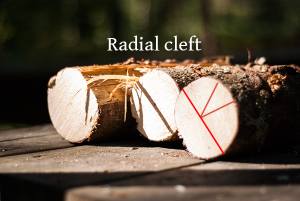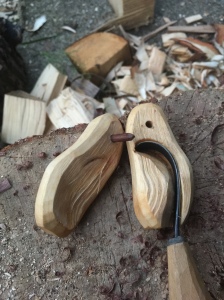Green woodworking is full of interesting words which make little sense outside the community. So, here we’ll continuously compile a list of useful terms, and some context to make sense of them.
Beetle
Club, mallet, beater, hitting thing – green woodworkers have a frequent need for a tool to encourage sudden movement through the physical principle of percussive shock. In other words, we often need to beat things. So, we use a beetle. Beetles are wooden clubs or mallets which let us hit steel tools or wooden pegs without damaging them. They can pound on the back of a froe, axe or wedge to cleave logs into billets. They can set wedges or pegs. And, they are often used to set the key wedges that hold the poppets fast in the bed of a pole lathe. Some people design and build beautiful beetles shaped like mallets with metal bands to hold them together. Others opt for cruder things like a handy stick or a small log with a roughly-shaped handle cut from one end.
Billet
Billets are bits of wood which have been split from a log into the desired thickness for whatever they will be made into.
Blank
Blanks are bits of wood which have been roughly shaped into their intended product. Usually, blanks are the next step after cutting or splitting a log. There are several kinds of blank, including:
- Bowl blank – a piece which has been hewn or cut roughly into the shape of a bowl, ready to be turned on a lathe
- Spindle blank – a piece which has been split into a billet and axed or shaved into a rough cylinder, ready to be turned on a lathe
- Spoon blank – a piece which has been split into a billet, then roughly axed and/or sawn into the general shape of a spoon
Bodger (or bodging)
Bodgers are green woodworkers who tend to focus on building furniture. By using the shrinkage of wood as it dries, bodgers can build things that lock together tightly without needing glue or fixings. They traditionally use hand tools and a pole lathe.
Bowl hook
Bowl hooks are simple, hook-shaped tools traditionally made by the turner themselves, to shape bowls on a pole lathe. This is also sometimes called a hook tool – not to be confused with a hook knife. The turner uses the edge of the hook to pare away shavings as the blank rotates.
Checking
Checking refers to how wood naturally splits as it shrinks. Checking lines tend to radiate out from the centre of the end-grain.
Cleaving (or cleft)
The word cleave simply means to split. Green woodworking traditionally relies on wood which has been forced apart along its grain, instead of sawn. So, the word cleft tends to crop up more often in green wood circles than normal. Generally, there are two ways to cleave wood: radially and tangentially. Radial cleaving simply means splitting a log along lines from the centre of the log’s end outward (radii of a circle). Tangential cleaving means splitting against the radius.


Cleaving brake
A cleaving brake looks a bit like a gate or a pile of logs. It’s used to hold longer poles as they’re split through friction and leverage. By wedging in the splitting wood, you can use the brake to keep the long pole still enough to split, and manoeuvre it as you apply leverage from a froe, axe, or wedge. The brake also lets you adjust the split by pushing toward or away from the direction the wood is naturally splitting – giving you more control over the resulting shape of the cleft pieces.

Crook knife
Also called a spoon knife or hook knife, this is a curved blade used for hollowing out. The curve lets the blade shave out a depression, such as the bowl of a spoon.

Drawknife
A drawknife is a two-handled blade that’s pulled (drawn) towards the woodworker. They’re a versatile tool in application by being desperately simple in their use. They can be used to debark wood, or shape it using controlled, powerful strokes. When used with a shave horse, they become even more useful. When bodging, the drawknife and shave horse tend to form an integral step between log and furniture. After a billet is cleft from a log, it can be roughly shaped into a cylinder on a shave horse with a drawknife before being mounted into a pole lathe for turning. Drawknives are also used for shaping carved objects such as spoons. Some people prefer them to rough axe work. Others use drawknives as a second roughing-out step between rough, axed blanks and finished, carved spoons.
Froe
Froes are long-bladed, L-shaped splitting tools with a cutting bevel on the bottom of the L. The upright is a handle. Froes are beaten into the end-grain of the wood to be split, then their handles are levered – twisting the blade in the grain and forcing a split. They’re often used for cleaving billets from logs, splitting thin planks to make boards or shingles, or used to divide thinner stock into withies (small, springy bits of wood used for binding).
Kolrosing
Kolrosing is traditional decoration from Scandinavia. The carver uses knife cuts to inscribe patterns or even pictures. These single cuts are then filled with fine powder (traditionally charcoal – kolrosing means loosely “coal writing”) to create permanent inscriptions.
Pith
Pith is the spongy or hollow centre of a tree, surrounded by the innermost circle of growth rings. It is usually distinguished by being a different colour or texture, but it’s always in the middle of the rings (though not always at the dead centre of the log). Most projects need the pith removing, because it’s soft. The heartwood surrounding the pith shrinks at a different rate from the rest of the wood, and can cause splitting and checking.
Pole lathe
A lathe is a tool used to spin wood around to be shaped by the turner. A pole lathe is an old form of lathe powered by chord attached to a pedal (called a treadle) stamped down with the foot. They use a flexible pole (or other springy material) to return the treadle upwards. They are reciprocating lathes, which means they turn in one direction on the downward tread, and spin the other as the pole pulls the chord back up. In green woodworking, there are often two kinds of pole lathe used: the spindle lathe (for turning cylindrical objects such as chair legs) and the bowl lathe (for turning chunky blocks into bowls). Pole lathes tend to share certain features, including:
- Lathe bed – the flat surface perpendicular to the floor
- Poppets – upright blocks of wood used to hold the turning piece above the bed
- Pole (or bungee) – the spring that returns the treadle
- Tool rest – a horizontal surface to rest a tool on when turning
- Treadle – the lever which lets the turner pull a chord down with their foot
Shave horse
Shave horses are benches equipped with a foot-powered, pivot vice to hold work for shaping with pulled tools such as a drawknife. The work straddles the bench, using their feet to push the bottom of a lever away from them, forcing the other end down onto a block that clamps the workpiece onto the horse. This puts the person into a good position to pull away from the work with their upper body – drawing the tool through the wood – while pushing away with their feet – holding the work ever tighter.

Twca cam
Pronounced tooka kam and literally meaning bent knife (or similar) in Welsh, the twca cam is a large, well: bent knife. Similar to the crook knife, the blade is usually larger and equipped with a stocky handle. This large handle gives a carver both a longer lever for pivoting cuts, or a thicker shaft for twisting the blade through wood.
Your suggestion
If you’d like to contribute to the glossary, please add your suggestion below.
